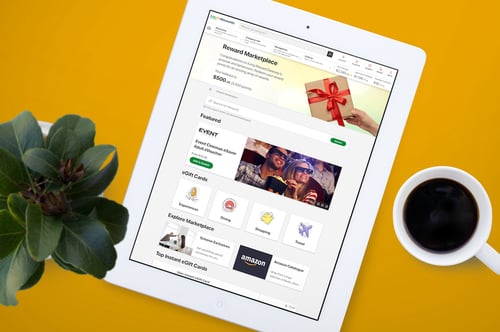Employers want a productive workforce and to be recognized for their efforts, and increasing productivity involves understanding how to incentivize employee performance. It’s an equation with a fairly simple solution. Using recognition and rewards programs is instrumental in increasing employee productivity.
In a recent report, we found a lot of elements of ‘work’ that impact productivity – it’s not just the environment, the role or the team at play, but also the array of benefits on offer and their work settings. For example, in our report, An EVP that Drives Engagement: The power of benefits, recognition and appreciation, 46% of U.S.-based employees said that time-off related benefits improve their productivity – taking higher priority than financial-related benefits (43%).
We dove deeper into productivity in our follow-up report, The Transformation of Work and Leadership: Engaging employees through respect and growth to find that 62% of employees are consistently productive. Fully remote employees reported the highest productivity at 69%; 63% of fully in-office workers are consistent, as well. But fewer employees in hybrid arrangements reported consistent productivity – only 48% of those in the office 2 days or fewer per week. Other key factors that influence productivity include personality type and relationships with management.
Ashley Whillan, an associate professor at Harvard Business School, also noted that the relationships between motivation, money and productivity have shifted – pure cash isn’t always the right incentive.
Whillan says, “With most of today’s employees, you’re trying to help instill intrinsic motivation, so they feel motivated to put in more effort out of enjoyment for what they do and appreciation for their jobs, rather than feeling extrinsically motivated by cash alone.”
These nuances make deploying an effective rewards program challenging for today’s employers.
So how can employers create an effective rewards and recognition platform – one that meaningfully recognizes employees in a way that resonates? You can start by focusing on data-driven strategies and leveraging tools to optimize the process.
10 steps to an effective R&R program
1. Ensure employees know how to earn rewards
 Ambiguous rewards guidelines can frustrate and alienate employees. Employees who are left in the dark about selection criteria may perceive unfairness or bias when recipients are announced.
Ambiguous rewards guidelines can frustrate and alienate employees. Employees who are left in the dark about selection criteria may perceive unfairness or bias when recipients are announced.
The best rewards programs clearly announce and communicate their judgment criteria. They also delineate the distribution process (e.g., who the decision makers are, which employees are eligible and who will receive what).
Employees who understand what they’re working toward – and perceive it as achievable – are more likely to boost their performance.
For example, say your company is launching a rewards-based wellness program. Be sure your employees understand what they need to do to earn a reward with this program, whether it’s by going to the doctor, running five miles or attending an event with coworkers. When your employees understand what boxes to check to earn rewards, they’re more likely to be engaged versus participating in rewards programs that lack clarity around earning criteria.
2. Tie rewards to performance standards
Another cardinal rule for a successful R&R program: Align rewards and recognition with employee performance.
Employees have to understand how their productivity and behaviors influence business outcomes. Employee rewards are a great way to demonstrate, reward and enforce this on a granular level.
 For example, if your organization has a particular initiative to focus on, you can set up a rewards program to incentivize participation, promotion or adherence (depending on what it is). Let’s say your company has a quarterly goal to gather more customer testimonials about your product. You can set up a rewards program for your customer service team, incentivizing them to reach out to their customers for quotes. Reward outstanding performers with a gift card, catered (or covered) lunch or exclusive company swag.
For example, if your organization has a particular initiative to focus on, you can set up a rewards program to incentivize participation, promotion or adherence (depending on what it is). Let’s say your company has a quarterly goal to gather more customer testimonials about your product. You can set up a rewards program for your customer service team, incentivizing them to reach out to their customers for quotes. Reward outstanding performers with a gift card, catered (or covered) lunch or exclusive company swag.
It’s also important to communicate exactly how employees can earn rewards. You can reward and recognize employees based on performance data. Performance data empowers employees and managers to have consistent, open discussions about performance and progress against professional and organizational objectives. Many companies leverage digital HR tools to provide managers and employees access to dashboards with real-time performance metrics. This ensures rewards are given meritoriously, based on objective data. Doing so will provide all parties with a better understanding of the correlation between productivity and incentive.
3. Offer unique rewards
Offering a variety of unique and valuable rewards can incentivize employees to work harder and smarter. Every workplace has its own unique culture, so what your workforce seeks in a rewards program may differ greatly from the wants of another organization’s employees.
It’s important to look beyond purely financial incentives and find out what your employees are looking for.
Do they want scheduling freedom? Maybe they place a greater value on social events or a nice catered lunch. Perhaps it’s a combination of all of the above. It’s imperative to insert whatever is important to your workforce into your strategy. Additionally, savvy leaders should magnify the lifecycle of the rewards process by publicly naming recipients. It’s key for you to recognize top performers in a company-wide email, newsletter or internal communications platform. This not only enhances the value through peer recognition for recipients, but also inspires other employees to perform at a higher level.
4. Recognize large and small achievements
Too often, companies obsess over major accomplishments. Of course, celebrating big wins is important, but tunnel vision on major accomplishments may detract from recognizing all the work that went into the smaller milestones along the way – milestones that were essential to making your big win happen.
Does your organization have a long-service award program? Consider adding a milestone before the five-year mark.
The Bureau of Labor Statistics reported that in January 2024, the median employee tenure is 3.9 years. Adding a reward milestone at the 2- or 3-year anniversary mark to your long-service program is one easy way to boost retention, engagement and morale.
Your rewards program should be tiered, offering up recognition and perks throughout the lifecycle of a project, not just at the finish line. In this way, your employees will feel supported and motivated every step of the way, leading to a productivity boost.
5. Incentivize teamwork
 Teamwork amplifies each individual’s productivity, leading to greater business outcomes. Plus, strengthening relationships within and between departments improves collaboration, innovation, and communication throughout your company. A great rewards program should focus on engaging and rewarding team efforts.
Teamwork amplifies each individual’s productivity, leading to greater business outcomes. Plus, strengthening relationships within and between departments improves collaboration, innovation, and communication throughout your company. A great rewards program should focus on engaging and rewarding team efforts.
Your team-based rewards should be more substantial than individual rewards. Teamwork and collaboration take more time and project management skills, and you’ll want to establish a rewards system that can reward the entire group simultaneously. For example, if you assign a project to an engineering time and they tackle it in record time, consider rewarding them with a team outing to a location of their choice. Effective team-based rewards encourage and increase cooperation, engagement and employee productivity.
6. Gamify rewards, not recognition
A little friendly competition between peers is healthy in the workplace. However, it should be in moderation, especially considering the benefits of teamwork as touched on above.
An overly competitive environment can lead to unhappiness and employee burnout, which is the antithesis of a desirable rewards and recognition initiative.
 An effective rewards strategy will ideally include rewards earned through competition (e.g., gamification, gift cards, prizes, spot awards) and rewards earned through outstanding work (e.g., team lunches or handwritten notes or eCards). That way, your company offers a diverse array of rewards and employees feel a healthy amount of pressure from peers and managers to achieve at work.
An effective rewards strategy will ideally include rewards earned through competition (e.g., gamification, gift cards, prizes, spot awards) and rewards earned through outstanding work (e.g., team lunches or handwritten notes or eCards). That way, your company offers a diverse array of rewards and employees feel a healthy amount of pressure from peers and managers to achieve at work.
While you can get away with gamifying rewards in moderation, do not gamify your recognition program. Gamifying recognition removes the impact of genuine recognition and can encourage employees to manipulate the system. Your priority with recognition should be to send genuine notes of appreciation to hard-working employees – a goal that evaporates once you gamify the system and make recognition competitive. This will actually result in a loss of productivity, as employees focus their efforts on how to get more recognition instead of excelling at their jobs, the very thing we want to recognize in the first place.
Reward Gateway | Edenred’s R&R strategy can be summed up with the AVI method: Detail the Action; connect it to an area of focus or company Value; explain the Impact the action has had. This method makes every recognition moment specific, both in terms of what is celebrated and why it matters. It also helps employees in other departments understand what their colleagues actually do and how their work contributes to business success.
7. Refresh your rewards frequently
Employees can quickly become bored with certain rewards, which can decrease the value of the reward over time. If you want employees to constantly strive for excellence, update your rewards often to create a sense of urgency with your employees.
 As mentioned previously, rewards can be tied to performance data. Employees shouldn’t be comfortable achieving the bare minimum for a reward. As your business objectives change, benchmarks for rewards and recognition should also evolve. Rewards should always be incentivizing, not a “given” in the workplace. Refresh them often to ensure your employees are always excited about their rewards program.
As mentioned previously, rewards can be tied to performance data. Employees shouldn’t be comfortable achieving the bare minimum for a reward. As your business objectives change, benchmarks for rewards and recognition should also evolve. Rewards should always be incentivizing, not a “given” in the workplace. Refresh them often to ensure your employees are always excited about their rewards program.
The Reward Gateway | Edenred Reward Marketplace is one easy way to diversify rewards offerings: In one simple interface, employees have access to hundreds of retailers across all categories to redeem their reward balances. Rather than a standardized set of items employees that employees aren’t invested in, employees can make their reward nearly anything they want, from treats to clothes to electronics and beyond!
8. Create personalized and specific recognition
A personalized approach better engages employees in the recognition process. 84% of employees say they feel more appreciated as a person when they receive customized recognition at work. Customized recognition also inspires longer tenure (for 81%), improves overall wellbeing (for 78%) and reduces stress levels (for 73%).
Recognition announcements and personal notes of appreciation are a vital part of building a productive workplace culture. When activities like this are vague or broad, the message becomes less genuine, and employees will pick up on that quickly.
 For example, let’s say you have an employee who’s going above and beyond to meet team goals. They’ve been with the company a few years and are consistently driving value for the business. A generic “Good Job!” or monetary reward does nothing to specify the impact this employee’s contributions have had on the company.
For example, let’s say you have an employee who’s going above and beyond to meet team goals. They’ve been with the company a few years and are consistently driving value for the business. A generic “Good Job!” or monetary reward does nothing to specify the impact this employee’s contributions have had on the company.
Instead, try recognizing hard working employees with a personalized touch like a handwritten letter or a one-on-one lunch with a member of the executive team. Experiences like these show your employees that you care about them and provide greater incentive to go above and beyond.
Larger companies may have trouble tailoring one-to-one recognition experiences. A judicious balance of automation and personalization goes a long way in helping all employees feel recognized and valued. Automating as many manual processes as possible, like gift card redemption and finding new rewards frees up leaders in your company to focus on injecting personal messaging into recognition.
9. Invest in personal development
One of the most valuable things you can do as a leader is to invest in the future of your talent. An upskilled workforce can drive value for your business, as well as establish trust and appreciation for top talent.
This type of employee reward may be more expensive, but it can pay dividends over time. Sponsor certifications for your high performers or pay for entry to a valuable conference. You can even encourage employees to take online training courses and assist with providing resources to do so. The knowledge gained is invaluable to their career and will enhance the quality of their work.
10. Donate to causes employees care about
Company culture is an extremely diverse concept that can be leveraged to reach every person in your workforce.
 Each workplace is made up of a wide spectrum of employees, each with differing perspectives, experiences, and values. The beauty of modern work is that all these different outlooks converge to create an environment that inspires and rewards excellence.
Each workplace is made up of a wide spectrum of employees, each with differing perspectives, experiences, and values. The beauty of modern work is that all these different outlooks converge to create an environment that inspires and rewards excellence.
Why not give back?
Social entrepreneurship is one of the fastest growing trends in business to date. It’s a great way to offer a reward that makes an impact outside of the office and creates a stronger bond between a company and its employees. This bond can be reflected in increased engagement, social advocacy and productivity.
Key Takeaways
Rewards and recognition are a win-win for employers and employees alike. Companies with optimized recognition programs can enjoy increased employee productivity and lower turnover rates.
Many HR technologists employ data to design and monitor the success of their employee rewards. Rewards and recognition programs that link incentives to performance data inform a better foundational understanding of what a “top performer” looks like, and are able to recruit and retain those workers.
Additionally, tracking the cost benefits of each reward offered enables your company to invest in the incentives that most impact employee productivity. Your workforce will contribute to organizational goals without consuming too much of your budget.
The employee experience will only continue to grow in importance in the future. If your business hopes to succeed, you should attract the right talent and provide those employees with a challenging, rewarding experience. For many workplaces, rewards and recognition programs are the perfect solution for both sides of that coin.
Editor’s note: This blog was originally published on fond.co, which was acquired by Reward Gateway in March 2023.
Learn more about how Reward Gateway | Edenred can support your organization’s efforts to recognize and reward your employees, ultimately making your corner of the world a better place to work.

 Kaitlin Howes
Kaitlin Howes





